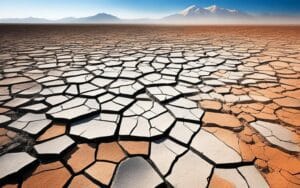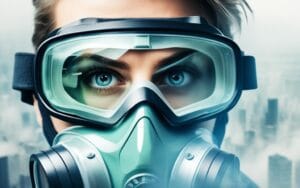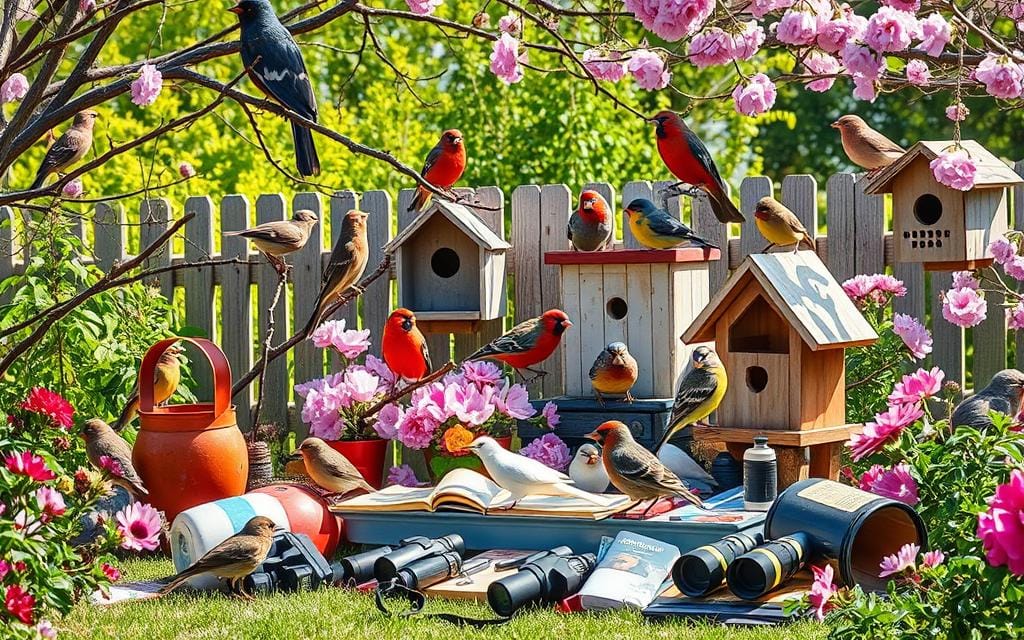Air pollution is a big global worry now. It upsets the balance of our ecosystems. This impacts the different plants and animals that live in them. From smog harming life to long-lasting damage from greenhouse gases, the effects are serious.
Air pollution messes up nature’s order and harms our planet’s many habitats. It’s important to see how air quality problems, environment damage, and emissions hurt the life around us. This shows why we need to find ways to protect our world.
Table of Contents
ToggleIntroduction to Air Pollution’s Impact on Biodiversity
Air pollution is a big issue that goes beyond affecting people’s health. It harms biodiversity, putting ecosystems at risk worldwide. It does this through things like environmental damage and greenhouse gas emissions. This is a big concern that needs our attention.
The Pressing Issue of Environmental Degradation
Air pollution hurts the environment and leads to many problems. This includes the loss of natural spaces and the extinction of some plants and animals. The pollution comes from industries and vehicles, causing harm to the ecosystems that support life.
Understanding the Importance of Ecological Balance
Maintaining a healthy ecosystem is highly important. Air pollution disrupts the balance that enables various life forms to survive. We must work to keep this balance to protect the many species that share our planet.
Air Quality and Its Consequences for Ecosystems
The air’s cleanliness is crucial for nature’s health. Smog is a major issue. It comes from industries, cars, and other sources, harming ecosystems.
Smog’s Detrimental Effects on Flora and Fauna
Urban areas and factories often suffer from smog. Its particles block plants from sun, reducing their growth. This leads to plant death and changes the look of the ecosystem. Also, animals breathe in these pollutants, causing health problems and even death.
These issues can greatly hurt the ecosystem’s health.
Industrial Emissions: A Threat to Natural Habitats
Industrial wastes are more than just smog. They contain harmful chemicals. These can destroy the earth, water, and air. Not only do they hurt plants and animals, but they also affect the whole ecosystem balance.
We need to act on smog and industrial pollution for nature’s sake. Air quality is connected to our planet’s health. Protecting the air helps save ecosystems and the many species that rely on them.
Greenhouse Gas Emissions and Biodiversity Loss
Air pollution, like greenhouse gases, is a major threat to nature. These gases include carbon dioxide, methane, and nitrous oxide. They capture heat in our atmosphere, warming the planet. This warming disrupts ecosystems, forcing many species to move or disappear.
The harm from these emissions is wide and challenging. They can change where plants and animals live and how they reproduce. This can lead to either tough adaptation or death. Also, melting ice from global warming raises sea levels. This can drown areas where sea life and coastal creatures live.
Moreover, extreme weather like droughts and floods is becoming more common. These events wipe out big groups of animals and plants. They especially hit those already struggling to survive.
| Greenhouse Gas | Impact on Biodiversity |
|---|---|
| Carbon Dioxide (CO2) | Alters temperature and precipitation patterns, leading to habitat loss and species migration |
| Methane (CH4) | Contributes to global warming, affecting ecosystems and disrupting food webs |
| Nitrous Oxide (N2O) | Increased nitrogen deposition can lead to eutrophication, harming aquatic and terrestrial habitats |
It’s key to fight these emissions and protect our planet’s life. We must use green energy and cut down on our carbon output. This way, we can save the wonderful and diverse life on earth.
Toxic Fumes: A Silent Killer for Plants and Animals
The impact of air pollution is broad. It directly harms the plants and animals in our environments. This damage is caused by toxic fumes from industrial work and cars. These dangers can disrupt ecosystems. They hurt the health and survival of many species.
Vehicular Emissions and Their Harm to Local Species
Vehicular emissions are a big part of city air pollution. They can hurt the plant and animal life around us. Harmful gases and tiny particles can cause health problems for animals. This includes trouble with breathing, weaker immune systems, and even death. These pollutants can also harm plants. They can slow down growth, stop the process that makes food, and open plants to sickness and pests.
The Invisible Dangers of Industrial Pollutants
Global industrial pollution is a major threat to our natural balance. Plants, animals, soil, water, and air can get poisoned by toxic chemicals. These dangers are unseen but very real. They can mess up the food chain, change plant life, and put many species at risk.
Acid Rain: A Destructive Force for Wildlife
Acid rain is a serious issue caused by air pollution. It comes from chemicals like sulfur dioxide and nitrogen oxides in the air. This type of rain can harm both water life and plants on land.
Aquatic Life at Risk from Acidification
When acid rain falls into lakes and rivers, the water’s pH level drops. This makes it hard for many aquatic creatures to live. Fish, frogs, and small water animals face a hard time surviving because the water changes too fast.
Forests and Vegetation Suffering from Acid Deposition
But, it’s not just water life that suffers. Trees and plants on land are at risk too. These chemicals from acid rain hurt their leaves. These plants can’t make food through photosynthesis, which hurts forests and all the creatures that rely on the plants for food or shelter.

how does air pollution affect biodiversity
Air pollution has a significant impact on the complex web of life around us. Greenhouse gases, industrial waste, and toxic fumes can throw off the balance in nature. This disruption affects the intricate relationships that help biodiversity thrive.
The Complex Web of Ecological Interactions
Not only does air pollution harm individual species, but it also damages the entire ecosystem. This ecosystem includes plants, animals, and many other life forms. The breakdown of these crucial connections can deeply disturb nature’s balance.
This disruption doesn’t only affect one species. It can have widespread and often unexpected effects. For instance, the loss of one type of plant can harm many animals and disrupt their environments.
Endangered Species at Greater Risk
Endangered species face a heightened risk because of air pollution. They already struggle with threats like habitat loss and climate change. Toxic pollutants make their survival even more challenging.
The impact of pollution accelerates the extinction risks for these vulnerable species. It also damages the natural balance that supports all life on Earth.
Ozone Depletion and Its Impact on Vulnerable Species
Air pollution harms our planet’s biodiversity by thinning the ozone layer. The ozone layer is a shield in the sky. It blocks harmful UV radiation from the sun. But, by lessening this layer, more UV rays can reach Earth. This causes great harm to our ecosystems.
Increased UV Radiation and Its Consequences
As the ozone layer gets thinner, more UV radiation touches our world. This is bad for plants and animals alike. Creatures like amphibians, ocean phytoplankton, and many plants are hit hard. Their fragile bodies can’t deal with so much UV. This harms the food chain, stops photosynthesis, and can lead to the failure of whole species.
Protecting Our Delicate Ecosystems
It’s important we act to stop ozone depletion’s effect on life. We should back global deals that cut ozone-hurting chemicals. Also, we should support research and technology. This can heal the ozone layer over time. By doing this, we help our vulnerable species and their homes survive environmental threats.
Environmental Regulations and Conservation Efforts
Air pollution is a big threat to our planet’s life. To fight this, we need rules, to save nature, and get everyone involved. Governments must lead the way to make real changes and protect our ecosystems.
The Role of Government Policies and Initiatives
It’s up to governments to make strong rules that reduce bad air and protect nature. They should make industries follow cleaner ways. Also, they should push for more clean energy and green transport options.
Public Awareness and Individual Responsibility
But, we all have a part to play. Knowing about air pollution and its effects is key. By teaching everyone how to live greener, we can all do our part.
With smart laws and everyone doing their bit, we can keep our planet healthy. Let’s all work together to protect the many plants and animals that share our world.
Sustainable Solutions for Reducing Air Pollution
Air pollution affects biodiversity. To tackle this issue, exploring and using sustainable solutions is key. We focus on two main areas: renewable energy and green transportation.
Promoting Renewable Energy Sources
Using solar, wind, and water power helps lower pollutants like greenhouse gases. These are linked to climate change and air pollution. By expanding renewable energy, we cut down on these threats.
Embracing Green Transportation Options
To fight air pollution, we must use more eco-friendly ways to travel. This includes electric cars, buses, trains, and walking or cycling. Moving from gas to green vehicles helps keep our air clean and protects nature.
| Sustainable Solution | Benefits for Biodiversity |
|---|---|
| Promoting renewable energy sources | Reduced greenhouse gas emissions, mitigating climate change and protecting vulnerable ecosystems |
| Embracing green transportation options | Decreased air pollution, improving air quality and supporting the health of local flora and fauna |
The Future of Biodiversity in a Changing Climate
In the future, the fate of biodiversity is closely tied to climate change and air pollution. Yet, by acting decisively and being resilient, we can protect the natural world. Our actions today can ensure its survival for the future.
Adapting to Environmental Challenges
Saving our ecosystems from the effects of pollution and climate change is vital. To do so, we need new ways to protect our lands and develop stronger plants and animals. Through research and good policies, we empower communities to face these challenges. This will help keep our natural heritage safe for years to come.
Preserving Our Natural Heritage
We must preserve the rich biodiversity in our natural spaces. This includes saving endangered species and their homes. But it also means helping people understand and value all life on Earth. By educating and supporting conservation, we can keep our natural world beautiful. This way, its wonder will live on for our children and their children.
FAQ
How does air pollution affect biodiversity in our world?
Air pollution is a big issue worldwide. It endangers the balance of our ecosystems and the varied life they hold. The damage from air pollution can be severe for natural environments.
What are the pressing issues of environmental degradation caused by air pollution?
Air pollution hurts our world in many ways. It affects human health and also the balance of life in ecosystems globally. This is a big problem for our planet.
How does air quality impact the health of ecosystems?
The air we breathe affects nature’s health. Smog, a result of industrial and vehicle emissions, is very harmful. It upsets the natural balance in ecosystems.
How do greenhouse gas emissions contribute to biodiversity loss?
Greenhouse gases are a big problem for biodiversity. They include gases like carbon dioxide and methane. These trap heat in the atmosphere, leading to climate change.
What are the impacts of toxic fumes on plants and animals?
Air pollution doesn’t just affect the whole environment. It can be directly harmful to plants and animals too. Life in natural areas suffers greatly from this pollution.
How does acid rain damage wildlife and vegetation?
Acid rain is a lesser-known but serious effect of air pollution. It is caused by sulfur dioxide and nitrogen oxides. This rain harms both water and land-based life forms.
How does the complex web of ecological interactions affect biodiversity?
The effects of air pollution are widespread and complex. They go through the entire network of life on our planet. Biodiversity faces a big challenge because of this.
How does ozone depletion impact vulnerable species?
Ozone layer depletion is a major issue from air pollution. This problem affects many species in our world. It’s a risk for biodiversity.
What is the role of government policies and public awareness in addressing air pollution’s impact on biodiversity?
Both policies and public awareness are key in fighting air pollution. We need laws, nature protection, and everyone to be informed. This teamwork is vital for our planet.
What are some sustainable solutions for reducing air pollution and protecting biodiversity?
To tackle air pollution and protect life, we need sustainable solutions. It’s important to find and use methods that don’t harm the environment. This way, we can work against pollution.
How can we adapt to environmental challenges and preserve our natural heritage?
Our changing climate and pollution put biodiversity at risk. Yet, with strong and smart efforts, we can safeguard nature. This includes working together and staying adaptable.









